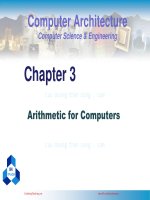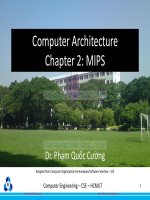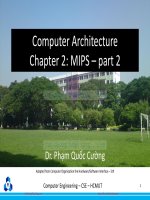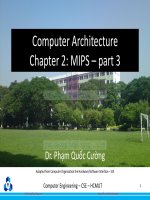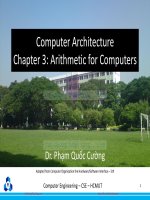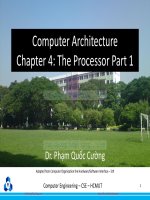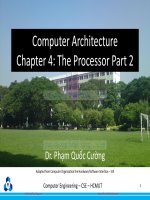kiến trúc máy tính phạm minh cường chương ter2 part1 instructions language of the computer sinhvienzone com
Bạn đang xem bản rút gọn của tài liệu. Xem và tải ngay bản đầy đủ của tài liệu tại đây (1.09 MB, 27 trang )
Computer Architecture
Chapter 2: MIPS
Dr. Phạm Quốc Cường
Adapted from Computer Organization the Hardware/Software Interface – 5th
Computer Engineering – CSE – HCMUT
CuuDuongThanCong.com
/>
1
Introduction
•
Language: a system of communication consisting of sounds, words, and grammar,
or the system of communication used by people in a particular country or type of
work (Oxford Dictionary)
/>CuuDuongThanCong.com
/>
2
Introduction (cont.)
• To command a computer’s hardware: speak its
language
/>CuuDuongThanCong.com
/>
3
Instruction Set Architecture (ISA)
4
CuuDuongThanCong.com
/>
Von Neumann Architecture
• Stored-program
concept
• Instruction category:
–
–
–
–
–
Arithmetic
Data transfer
Logical
Conditional branch
Unconditional jump
5
CuuDuongThanCong.com
/>
Computer Components
6
CuuDuongThanCong.com
/>
Instruction Execution
• Instruction fetch: from the memory
– PC increased
– PC stores the next instruction
• Execution: decode and execute
7
CuuDuongThanCong.com
/>
The MIPS Instruction Set
• MIPS architecture
• MIPS Assembly Inst. MIPS Machine Instr.
• Assembly:
– add $t0, $s2, $t0
• Machine:
– 000000_10010_01000_01000_00000_100000
• Only one operation is performed per MIPS
instruction
8
CuuDuongThanCong.com
/>
IS Design Principles
•
•
•
•
Simplicity favors regularity
Smaller is faster
Make the common case fast
Good design demands good compromises
9
CuuDuongThanCong.com
/>
MIPS Operands
• 32 32-bit registers
–
–
–
–
–
$s0-$s7: corresponding to variables
$t0-$t9: storing temporary value
$a0-$a3
$v0-$v1
$gp, $fp, $sp, $ra, $at, $zero, $k0$k1
• 230 memory words (4 byte): accessed only by data
transfer instructions (memory operand)
• Immediate
10
CuuDuongThanCong.com
/>
Arithmetic Instructions
Opcode
Destination
register
Source
register 1
Source
register 2(*)
• Opcode:
– add: DR = SR1 + SR2
– sub: DR = SR1 – SR2
– addi: SR2 is an immediate (e.g. 20), DR = SR1 +
SR2
• Three register operands
11
CuuDuongThanCong.com
/>
Design Principle 1
• Simplicity favours regularity
– Regularity makes implementation simpler
– Simplicity enables higher performance at lower
cost
12
CuuDuongThanCong.com
/>
Arithmetic Instructions: Example
• Q: what is MIPS code for the following C code
f = (g + h) – (i + j);
If the variables g, h, i, j, and f are assigned to the
register $s0, $s1, $s2, $s3, and $s4,
respectively.
• A:
add $t0, $s0, $s1 # g + h
add $t1, $s2, $s3 # i + j
sub $s4, $t0, $t1 # t0 – t1
13
CuuDuongThanCong.com
/>
Data Transfer Instructions
• Move data b/w memory
and registers
– Register
– Address: a value used to
delineate the location of
a specific data element
within a memory array
• Load: copy data from
memory to a register
• Store: copy data from a
register to memory
14
CuuDuongThanCong.com
/>
Data Transfer Instructions (cont.)
Opcode
Register
Memory
address
• Memory address: offset(base register)
– Byte address: each address identifies an 8-bit byte
– “words” are aligned in memory (address must be
multiple of 4)
15
CuuDuongThanCong.com
/>
Data Transfer Instructions (cont.)
• Opcode:
–
–
–
–
–
–
–
–
–
–
–
lw: load word
sw: store word
lh: load half ($s1 = {16{M[$s2+imm][15]},M[$s2 + imm]})
lhu: load half unsigned ($s1 = {16’b0,M[$s2 + imm]})
sh: store half
lb: load byte
lbu: load byte unsigned
sb: store byte
ll: load linked word
sc: store conditional
lui: load upper immediate $s1 = {imm,16’b0}
16
CuuDuongThanCong.com
/>
Memory Operands
• Main memory used for composite data
– Arrays, structures, dynamic data
• To apply arithmetic operations
– Load values from memory into registers
– Store result from register to memory
• MIPS is Big Endian
– Most-significant byte at least address of a word
– c.f. Little Endian: least-significant byte at least address
17
CuuDuongThanCong.com
/>
Memory Operand Example 1
• C code:
g = h + A[8];
– g in $s1, h in $s2, base address of A in $s3
• Compiled MIPS code:
– Index 8 requires offset of 32
• 4 bytes per word
lw $t0, 32($s3)
add $s1, $s2, $t0
# load word
18
CuuDuongThanCong.com
/>
Memory Operand Example 2
• C code:
A[12] = h + A[8];
– h in $s2, base address of A in $s3
• Compiled MIPS code:
– Index 8 requires offset of 32
lw $t0, 32($s3)
# load word
add $t0, $s2, $t0
sw $t0, 48($s3)
# store word
19
CuuDuongThanCong.com
/>
Registers vs. Memory
• Registers are faster to access than memory
• Operating on memory data requires loads and
stores
– More instructions to be executed
• Compiler must use registers for variables as
much as possible
– Only spill to memory for less frequently used
variables
– Register optimization is important!
20
CuuDuongThanCong.com
/>
Immediate Operands
• Constant data specified in an instruction
addi $s3, $s3, 4
• No subtract immediate instruction
– Just use a negative constant
addi $s2, $s1, -1
• Design Principle 3: Make the common case
fast
– Small constants are common
– Immediate operand avoids a load instruction
21
CuuDuongThanCong.com
/>
The Constant Zero
• MIPS register 0 ($zero) is the constant 0
– Cannot be overwritten
• Useful for common operations
– E.g., move between registers
add $t2, $s1, $zero
22
CuuDuongThanCong.com
/>
Unsigned Binary Integers
• Given an n-bit number
x x n1 2n1 x n2 2n2 x121 x 0 20
• Range: 0 to +2n – 1
• Example
– 0000 0000 0000 0000 0000 0000 0000 10112
= 0 + … + 1×23 + 0×22 +1×21 +1×20
= 0 + … + 8 + 0 + 2 + 1 = 1110
• Using 32 bits
– 0 to +4,294,967,295
23
CuuDuongThanCong.com
/>
2s-Complement Signed Integers
• Given an n-bit number
x x n1 2n1 x n2 2n2 x1 21 x 0 20
Range: –2n – 1 to +2n – 1 – 1
• Example
– 1111 1111 1111 1111 1111 1111 1111 11002
= –1×231 + 1×230 + … + 1×22 +0×21 +0×20
= –2,147,483,648 + 2,147,483,644 = –410
• Using 32 bits
– –2,147,483,648 to +2,147,483,647
24
CuuDuongThanCong.com
/>
2s-Complement Signed Integers
• Bit 31 is sign bit
– 1 for negative numbers
– 0 for non-negative numbers
• –(–2n – 1) can’t be represented
• Non-negative numbers have the same unsigned and
2s-complement representation
• Some specific numbers
–
–
–
–
0: 0000 0000 … 0000
–1: 1111 1111 … 1111
Most-negative: 1000 0000 … 0000
Most-positive: 0111 1111 … 1111
25
CuuDuongThanCong.com
/>


